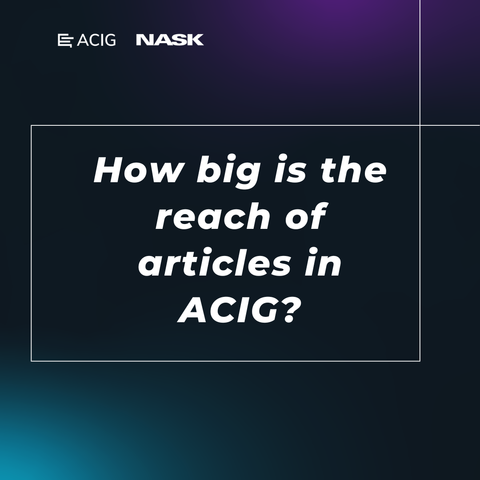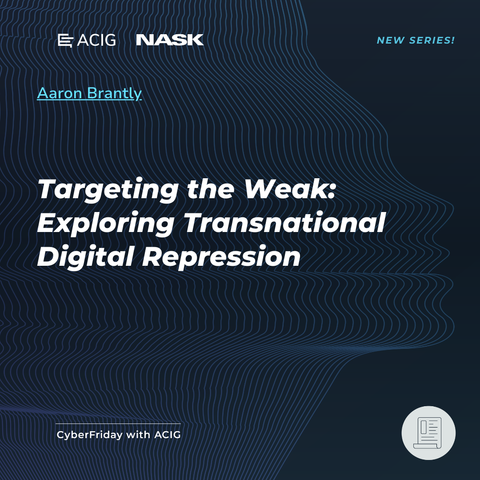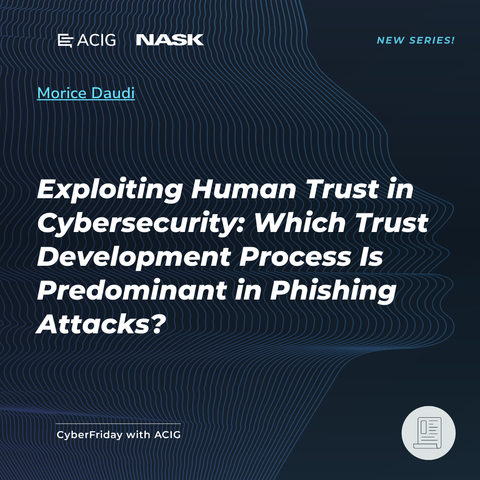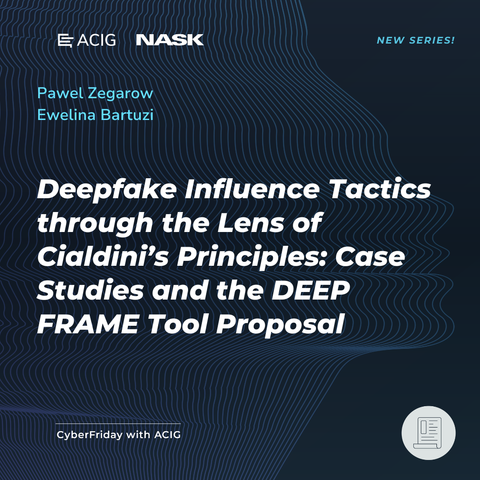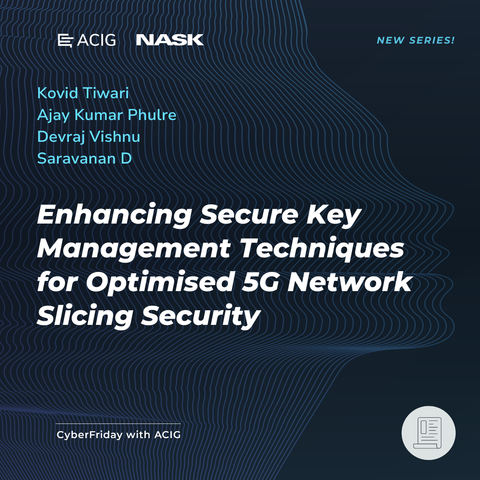This #cyberFriday our eyes turn towards #Ukraine, where military and diplomatic situation is still tense and unpredictably changing. Modern warfare spills into the #cybersecurity area more than ever before, and thus we would like to recommend to you again a paper from our last year’s special issue on the Russian-Ukrainian war (vol.3, no.1).
✍️ In his article “Russia’s Cyber Campaigns and the Ukraine War: From the ‘Gray Zone’ to the ‘Red Zone’” Kristan Stoddart remarks: “Hitherto, there has been a lack of in-depth, systematic studies in relation to state-on-state cyber attacks (…) For the Kremlin, hybrid warfare (gibridnaya voina) is fought with all the tools at their disposal on a ‘battlefield’ that stretches beyond the four modern domains of land, sea, air, and space. The fifth domain of cyberspace is increasingly important for espionage, cyberwar, and influence operations”.
➡️ Learn how Kristan Stoddart’s analysis sought to make up for this lack at https://www.acigjournal.com/Russia-s-Cyber-Campaigns-and-the-Ukraine-War-From-the-Gray-Zone-to-the-Red-Zone-,189358,0,2.html
#CyberFriday
This #CyberFriday, we’re excited to share how well articles published in #ACIG are doing!
Based on CrossRef data, over one-third of the articles from our first four issues (Nos. 1–3(2)) have been cited at least once, with an average of more than two citations each. Our most popular article, “Regulating Deep Fakes in the Artificial Intelligence Act” by Mateusz Łabuz, has reached ten citations!
Some articles have also passed a thousand views and hundreds of downloads on our website.
None of this would be possible without the amazing Authors who publish with us. As a platinum #OpenAccess journal, we focus on partnering with and supporting researchers in #Cybersecurity.
If you’re a computer science or information security researcher (or know someone who is), consider publishing with ACIG!
Come and read the newest article!
⚠️ With cyber-attacks against critical infrastructure, threat of foreign influence on the electoral process, and disinformation campaigns, much of the attention in the #cybersecurity field focuses on activities of states aimed against other states.
Yet there is another side to this issue: transnational repression enacted by state actors against diaspora communities of minority groups and civil-society organisations seeking refuge in third-party nations.
🔍 In his paper “Targeting the Weak: Exploring Transnational Digital Repression” Aaron Brantly @afterwestphalia offers an in-depth analysis of this emerging issue. Read it in open access on our website: https://www.acigjournal.com/Targeting-the-Weak-Exploring-Transnational-Digital-Repression,203788,0,2.html
#humanRights #sovereignty #NASK #transnationalRepression #cyberFriday
This #cyberFriday let’s talk trust 🤝
🔎 With the cyberwarfare arms race taking place all around us, the so-called human element – specifically our naivety and tendency to let down our guards – often remains the weakest links of many cybersecurity systems.
💡 As Morice Daudi points out, #phishing remains one of the most prevalent forms of cybercrime. Today we would like to remind you of his article “Exploiting Human Trust in Cybersecurity: Which Trust Development Process Is Predominant in Phishing Attacks?” in which an analysis of the most popular trust development mechanisms used by cybercriminals is presented. Conducting a qualitative analysis of phishing message examples, Morice Daudi focuses on the two most common psychological tricks used by attackers – invoking the relationship history and raising future expectations of a potential gain. The paper concludes with practical recommendations for organisations and individuals.
Read in in open access on our website 👇
https://www.acigjournal.com/Exploiting-Human-Trust-in-Cybersecurity-Which-Trust-Development-Process-Is-Predominant,199452,0,2.html
🌐 In the age of rising international tensions and rapid technological development presenting us with previously unheard-of issues, efficient #cybersecurity measures are not only a personal responsibility but also a systemic challenge that needs to be addressed at the state level.
🇩🇰 This #cyberFriday, we invite you to read a case study of the strategy employed by the Danish government. In his article “Denmark’s Sector Responsibility Principle: A Tedious Cyber Resilience Strategy,” Mikkel Storm Jensen discusses the implementation of the National Cyber and Information Security Strategy, under which the state delegates tasks to individual sectors while coordinating efforts and implementing recommendations for greater resilience. He discusses its legal, organizational, and political aspects, comparing the Danish approach to examples from other countries and highlighting the challenges it still faces. His analysis is well worth reading.
You can find the full text on our webpage, as always in open access 👇
https://www.acigjournal.com/Denmark-s-Sector-Responsibility-Principle-A-Tedious-Cyber-Resilience-Strategy,190789,0,2.html
This week April Fools’ Day was celebrated. The internet was awash with satirical social media posts and humorous news headlines, many of them accompanied by comical AI-generated pictures of surreal and surprising situations. However, deepfake technology is not a laughing matter when it is used for disinformation and criminal activity. How can we counter its illegal and unethical use?
This #CyberFriday we invite you to read the article “Deepfake Influence Tactics through the Lens of Cialdini’s Principles: Case Studies and the DEEP FRAME Tool Proposal” by Paweł Zegarow and Ewelina Bartuzi, PhD. Their paper assesses the psychological influence of fake AI-generated content in the context of Dr. Robert Cialdini’s model of six principles of persuasion and proposes a novel tool for interdisciplinary analysis of deepfakes’ influence – the DEEP FRAME checklist for examining and recording deepfake material. Read the full article on our website:
➡️ https://www.acigjournal.com/Deepfake-Influence-Tactics-through-the-Lens-of-Cialdini-s-Principles-Case-Studies,201147,0,2.html
🌐ACIG by #NASK
This #CyberFriday we will try to find an answer on how to fight a key tactic of disinformation. In the important paper "AI in Disinformation Detection", Julia Puczyńska and Youcef Djenouri focus on the DISARM Framework and UQ as key tools for building transparent, resilient defenses against evolving disinformation campaigns. The article concludes by outlining future directions for developing scalable, transparent, and resilient systems to safeguard information integrity and societal trust in an increasingly digital age.
The paper is available in the Online First section on our site👇
https://www.acigjournal.com/AI-in-Disinformation-Detection,200200,0,2.html
🌐ACIG is published by NASK - National Research Institute
#CyberFriday is the time for a showcase of another insightful article by our brilliant Authors 🔍
Mateusz Nawrocki and Joanna Kołodziej compare the experimental results of simulated cyberattacks in scenarios with different security strategies.
Read their article here 👇
https://www.acigjournal.com/Vulnerabilities-of-Web-Applications-Good-Practices-and-New-Trends,199521,0,2.html
This week’s #CyberFriday falls just a day before #InternationalWomensDay, making it the perfect moment to celebrate the brilliant female authors whose work has been published in ACIG’s Journal. Women make up roughly a third of the researchers we collaborate with – we are proud to be their journal of choice, but we know there is still more to do.
We remain committed to upholding the highest standards of equality and equity, ensuring that our platform is open to all researchers who can contribute to the cybersecurity debate.
This #CyberFriday 🚨 we would like to present you with an article that tackles the issues of computer network safety from a rigorously technical point of view.
🛜 5G communication is a modern standard of fast wireless connectivity. But managing large amounts of data uploaded and downloaded by many agents in real-time poses a challenge of doing so effectively and safely. In their research paper “Enhancing Secure Key Management Techniques for Optimised 5G Network Slicing Security” Kovid Tiwari, Ajay Kumar Phulre, Devraj Vishnu and Saravanan D introduce a cryptographic framework that could increase security and efficiency of the #5G communication systems. Give their work a read!
The paper will become a part of the upcoming issue of ACIG Journal. It is already available in the Online First section on our site👇
https://www.acigjournal.com/Optimizing-5G-Network-Slicing-with-Secure-Key-Management-Techniques,199725,0,2.html
🌐Applied Cybersecurity & Internet Governance (#ACIG), is published by #NASK - National Research Institute

